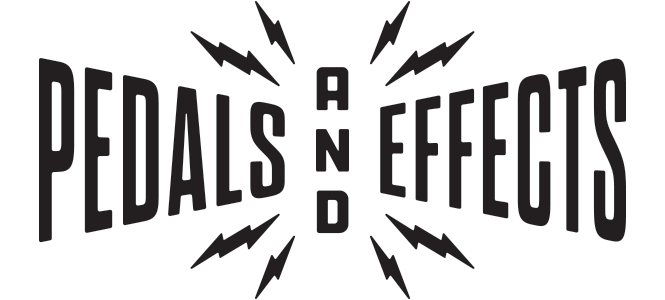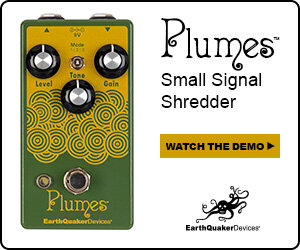Throwback Thursday: How To Build A Great Pedalboard
/This was on top of the SVT Cabinets at one point.
The pedalboard you see here was the one I used on the Frances The Mute tour, and that was the last time I used such a massive one. It was comprised of three boards which surrounded me, then one more pedalboard on top of the Ampeg 8×10 cabinets. Not only was it a lot of road cases, it was a lot of weight. The crew told me that my bass rig was the heaviest of all band members gear- my stuff weighed more than all the drum cases combined! Here’s the list:
- 2 Ampeg SVT 8×10 cabinets in road cases
- 3 Ampeg SVT vintage heads in road cases
- 4 pedalboards in road cases
- At least five basses (all Fender) – 2 Geddy Lee basses, 2 fretless Precision basses, one modded Geddy Lee bass (shown here)
- I also had an Evil Twin direct box and assorted speakers, cables, pickups, tubes, and pedals for either future use or back up, all in a giant road case with my strings and picks.
Not a lot of bands or musicians get the chance to be this overindulgent, but it was at a time when The Mars Volta was trying to reach beyond past and present, and we did whatever had been done. I got to drive my bass tech, Jerry Riccardi, crazy by always trying pedals on pedalboards and then yanking them off and replacing them with others. As my pedalboard grew, Jerry would have to build the board in the chain that I had dreamed up. It was an exciting time for me, but likely a taxing time for Jerry, even though he never complained (thanks Jerry!).
The reason some pedals got booted for others was simple- I just didn’t use them as much as the others. One pedal that got taken off was my Digital Whammy pedal. Although it was a great pedal, the band needed me to always maintain a certain frequency level so going up an octave was not an option. Dropping down was cool but I had other pedals that did that. The Whammy also took up a ton of space due to its large size, so that was another reason why I’d yank it so I could replace the same real estate with two pedals.
Another pedal that didn’t last long in its position was the Fulltone Octafuzz. That pedal sucked too much low end, and again, I couldn’t have a pedal take me out of the frequency range in which the band needed me. It had a cool, saturated sound but in the end, it also didn’t work as well as other fuzzes I owned and it never worked well with other pedals.
My Ernie Ball volume pedal was another pedal that was removed because of it’s size and lack of use. Instead of using the volume pedal for volume dynamics, I would just shut off my Boss CS-2 compressors to bring down my volume. It wasn’t the same tone but I figured when we’d drop in volume, the full dynamics of my tone weren’t being heard through the PA speakers anyway. I eventually put another CS-2 on my main board with a different setting so I could do dynamic shifts. Jerry called one CS-2, mild, and the other, spicy.
Another reason why some pedals were eliminated from the board was because of their gain structures. Let's take a look at two of some of my mainstays, the Moog Moogerfooger Ring Mod and the beloved Mu-Tron envelope filter.
Both pedals have gain/drive knobs on them and as a result, are not true bypass.
There was always a chance that these two particular pedals could affect my tone, volume and signal strength so I’d put them in a loop via the Boss line selector. By doing this, I essentially pulled the pedals out of the signal chain, so when I wanted to introduce the effect, I could just step on the Boss so the Mu-Tron or Moog would get pulled into the signal chain via the loop selector.
Additionally, having two loop pedals took up extra space. When I decided that had to go, I pulled the Mu-Tron because I didn’t use it as much. The Moog Ring Modulator was a big part of our songs so it won out.
In the end, it also comes down to trial and error, and just plain, personal preference. Some pedals got pulled just because the sound or function wasn’t to my liking. I once bought a Chopper pedal because of all the hype; turns out it was just that. All hype, nothing more.
I hope this post sheds some light on how I build my pedalboard. In the end, the deciding factors are based on what you need, what your band needs and ultimately, what sounds musical. Once you choose your pedals based on those criteria, be prepared to hear, “NO, you can’t do that!” from crew guys because of powering or cabling logistics, which are also important. It is all in the trial and error stage until you get what works, what sounds great and what makes you happy.
It was an honor working for TMV and Juan. I learned more during those years then all my other tours put together. It’s quite a badge of honor to walk on any stage in the world, look down at any pedal board and say, “eh, that’s cool, but I’ve had more….with a bass player.” I believe at the peak there were 42 pedals in the live rig. – Jerry Riccardi
You can find every single piece of gear mentioned here (unbelievable!) on Reverb.com. Explore what works, add more pedals, then downsize, find what sounds define you and makes you unique!













